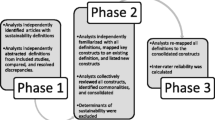Abstract
The U.S. Preventive Services Task Force’s “Guide to Clinical Preventive Services” summarizes the results of a critical review of the literature pertaining to the effectiveness of 169 interventions in modifying 60 risk factors or conditions. The ultimate impact of the guide depends on the diffusion into clinical practice of its recommendations. This report reviews the factors influencing the diffusion process. Three categories of behavioral influence—predisposing, enabling, and reinforcing factors—apply to this diffusion process. Predisposing factors include knowledge and attitudes, personal health behaviors, confidence, and beliefs about patients’ interests in health-promotion advice. Enabling factors include competence to perform preventive services, reimbursement for preventive services, organization of the practice setting, time to provide preventive services, a reminder system, and a coherent set of guidelines that are perceived as scientific and unambiguous. Reinforcing factors include peer support, feedback, evidence of results, and an enhanced sense of self-efficacy in fulfilling one’s role as a healer. Recommendations are given for using these factors to increase the diffusion of preventive services into clinical practice.
Similar content being viewed by others
References
Rogers EM. Diffusion of innovations. 3rd ed. New York: Free Press, 1982.
Green LW, Eriksen MP, Schor EL. Preventive practices by physicians: behavioral determinants and potential interventions. Am J Prev Med. 4(4)1988;S101–7.
Pels RJ, Bor DH, Lawrence RS. Decision making for introducing clinical preventive services. Annu Rev Public Health. 1989;10:359–79.
Sacket D. Screening in family practice: prevention, levels of evidence, and the pitfalls of common sense. J Fam Pract. 1987;24:233–4.
Orlandi MA. Promoting health and preventing disease in health care settings: an analysis of barriers. Prev Med. 1987;16(1):119–30.
Haynes RB, Davis DA, McKibbon A, et al. A critical appraisal of the efficacy of continuing medical education. JAMA. 1984;251:61–4.
Stross JK, Bole GG. Evaluation of a continuing education program in rheumatoid arthritis. Arthritis Rheum. 1980;23:846–9.
Valente CM, Sobal J, Muncie HL, et al. Health promotion: physicians’ beliefs, attitudes and practices. Am J Prev Med. 1986;2:82–8.
Avorn J, Soumerai SB. Improving drug-therapy decision through educational outreach. N Engl J Med. 1983;308:1457–63.
Thompson RS, Kirz HL, Gold RA. Changes in physician behavior and cost savings associated with organizational recommendations on the use of “routine” chest x-rays and multichannel blood tests. Prev Med. 1983;12:385–96.
Laxdal OE, Jennett PA, Wilson TW, et al. Improving physician performance by continuing medical education. Can Med Assoc J. 1978;118:1051–8.
Henry RC, Ogle KS, Snellman LA. Preventive medicine: physician practices, beliefs, and perceived barriers for implementation. Fam Med. 1987;19:110–3.
Johns M, Hovell M, Ganiats T, et al. Primary care and health promotion: a model for preventive medicine. Am J Prev Med. 1987;6:346–58.
Wyshak G, Lamb GA, Lawrence RS, et al. A profile of health-promoting behavior of physicians and lawyers. N Engl J Med. 1980;304:104–7.
Goodman LJ. The longevity and mortality of American physicians, 1969–73. Milbank Q. 1975;53:353–75.
Cummings KM, Giovino G, Sciandra R, et al. Physician advice to quit smoking: who gets it and who doesn’t. Am J Prev Med. 1987;3:69–75.
Kottke TE, Foels JK, Hill C, et al. Nutritional counseling in private practice: attitudes and activities of family physicians. Prev Med. 1984;13:219–25.
Health promotion and disease prevention, United States. Data from the national health survey, 1985. Series 10, no 169, 91 pp.
Relman AS. Encouraging the practice of preventive medicine and health promotion. Public Health Rep. 1982;97:216–9.
Rosen MA, Logsdon DN, Demak MM. Prevention and health promotion in primary care: baseline results on physicians from the INSURE project on lifestyle preventive health services. Prev Med. 1984;13:535–48.
Lurie N, Manning WG, Peterson C, et al. Preventive care: do we practice what we preach? Am J Public Health. 1987;77:801–4.
Woolhandler S, Himmelstein D. Reverse targeting of preventive care due to lack of health insurance. JAMA. 1988;259:2872–4.
Luft HS. Assessing the evidence on HMO performance. Milbank Q. 1980;58:501–36.
Demak MM. Prevention in primary medical care. The INSURE project. Md Med J. 1983;32:279–93.
Logsdon DN. The evaluation of preventive health services in HMO primary care: the INSURE/GHC study. Menlo Park, CA: Henry J. Kaiser Family Foundation, 1987. Final report.
Frame PS, Kowulich BA, Llewellyn AM. Improving physician compliance with a health maintenance protocol. J Fam Pract. 1984;19:341–4.
McDonald CJ. Protocol-based computer reminders, the quality of care and the non-perfectability of man. N Engl J Med. 1976;295:1351–5.
Rosser WW, McDowell I. Discussion of preventive practices by physicians: behavioral determinants and potential interventions. Am J Prev Med. 1988;4(4):S108–10.
Gemson DH, Elinson J. Prevention in primary care: variability in physicians practice patterns in New York City. Am J Prev Med. 1986;2:226–34.
Perry S. The NIH consensus development program. A decade later. N Engl J Med. 1987;317:485–8.
Author information
Authors and Affiliations
Additional information
Received from the Cambridge Hospital, Cambridge, Massachusetts, and the Division of Primary Care, Harvard Medical School, Boston, Massachusetts.
Rights and permissions
About this article
Cite this article
Lawrence, R.S. Diffusion of the U.S. preventive services task force recommendations into practice. J Gen Intern Med 5 (Suppl 2), S99–S103 (1990). https://doi.org/10.1007/BF02600852
Issue Date:
DOI: https://doi.org/10.1007/BF02600852




